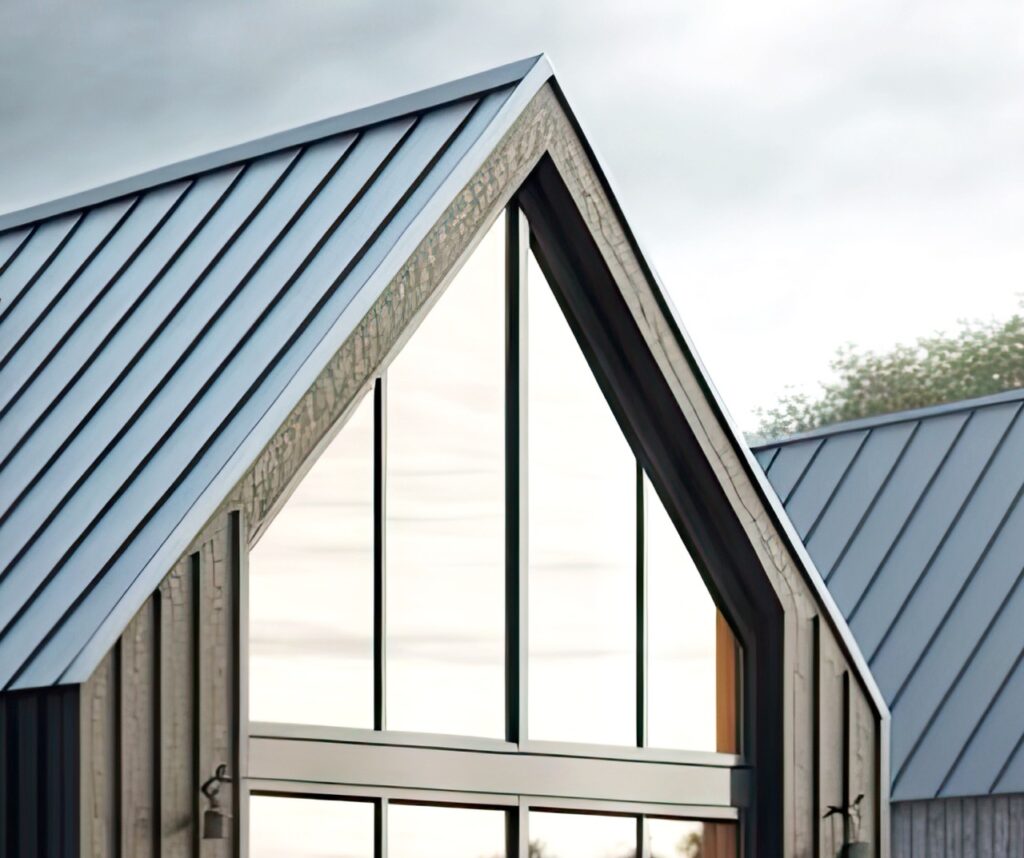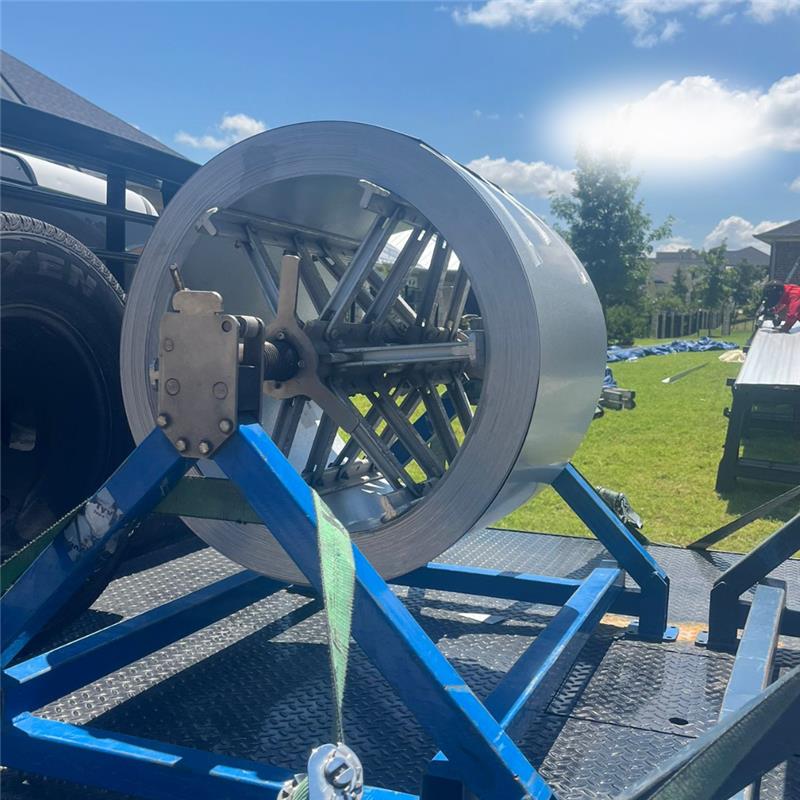When it comes to protecting your home from the elements, every component matters—including those parts you might not think about until there’s a problem. Your fascia board might not be the most glamorous part of your home’s exterior, but it plays a crucial role in protecting your roof structure and preventing water damage.
In San Antonio’s challenging climate, choosing the right fascia material becomes even more important. Have you ever wondered why more homeowners are switching from traditional wood fascia to metal alternatives? The answer lies in the remarkable durability, weather resistance, and long-term value that metal fascia offers. In this article, we’ll explore why metal fascia is increasingly becoming the material of choice for homeowners who want lasting protection against Texas’s intense sun, occasional heavy rains, and varying weather conditions.
Table of Contents
Understanding Fascia: The Unsung Hero of Your Roof System
What exactly is fascia and why does it matter?
Your home’s fascia is the vertical finishing edge connected to the ends of the rafters, trusses, or the area where the roof meets the outer walls of the house. Think of fascia as the final line of defense between your roof structure and the outside elements. It serves multiple critical functions: supporting the bottom row of roof tiles, carrying gutters, and preventing moisture and pests from accessing the roof structure.
Fascia boards are essentially the face of your roofline, which explains their name—”fascia” comes from the Latin word for “face” or “appearance.” Beyond their functional importance, fascia boards also play a significant aesthetic role, creating a smooth, finished edge that defines your home’s profile.
In Texas homes, where aesthetic appeal meets practical necessity, the fascia is constantly working to protect your investment. When this crucial component fails, the results can be catastrophic, leading to rotting roof decking, attic damage, and expensive repairs that could have been avoided with better materials.
The San Antonio Climate Challenge: Why Material Choice Matters
The unique weather patterns that test your home’s defenses
San Antonio’s climate presents a perfect storm of conditions that can wreak havoc on exterior building materials. With summer temperatures regularly exceeding 90°F and occasionally climbing past 100°F, materials expand and contract daily. The intense UV exposure breaks down organic materials at an accelerated rate, while sudden heavy downpours during storm seasons test water resistance to its limits.
This climate rollercoaster creates a uniquely challenging environment for building materials—especially those exposed to the elements year-round, like fascia boards. The high humidity levels common in San Antonio mean that any moisture that penetrates a material has difficulty escaping, creating ideal conditions for mold, mildew, and rot.
Local climate factors to consider include:
- Extended periods of intense sun and heat
- Seasonal heavy rainfall and potential flooding
- High humidity levels throughout much of the year
- Occasional freezing temperatures during winter months
- Potential for severe storms and high winds
For San Antonio homeowners, choosing fascia materials means finding options that can withstand this diverse array of challenges while maintaining their appearance and structural integrity for decades, not just years.
Wood Fascia: Traditional but Troublesome
Why the conventional choice falls short in Texas conditions
Wood fascia has been the traditional choice for generations of homebuilders, valued for its natural appearance and relatively easy installation. Typically made from cedar, pine, or other softwoods, these boards have a warm, classic appearance that complements many architectural styles.
However, when exposed to San Antonio’s climate conditions, wood fascia’s shortcomings become apparent quickly. Like a sponge left out in the rain, wood fascia inevitably absorbs moisture, especially during the humid months. This leads to a cascade of problems that homeowners discover all too late.
The primary issues with wood fascia include:
- Warping and twisting as moisture is absorbed and released
- Rotting and decay when water penetrates the material
- Cracking and splitting from sun exposure and temperature fluctuations
- Pest vulnerability, particularly to termites and carpenter ants
- Frequent maintenance requirements including sanding, painting, and sealing
- Short service life of 10-15 years even with proper maintenance
Think of wood fascia as an organic material doing its best in an environment designed to break it down. Even pressure-treated or specially sealed wood eventually succumbs to the elements, requiring replacement far sooner than homeowners might expect or budget for.
Metal Fascia: Engineered for Excellence
The modern solution designed for lasting performance
Metal fascia represents a significant evolution in building technology, specifically engineered to overcome the limitations of traditional materials. Unlike wood, metal fascia is typically made from aluminum or steel that has been treated to resist corrosion and coated with specialized finishes that enhance both durability and appearance.
If wood fascia is like a paper shield in a rainstorm, metal fascia is more like the hull of a battleship—designed from the ground up to withstand the harshest conditions while maintaining its integrity. These modern materials leverage decades of metallurgical advances to create products specifically suited to exterior applications in challenging climates.
The key features of quality metal fascia include:
- Corrosion-resistant base materials such as galvanized steel or aluminum
- Protective coatings that prevent oxidation and color fading
- Pre-finished options in a variety of colors that don’t require painting
- Precision manufacturing for consistent thickness and quality
- Specialized fastening systems designed for thermal expansion and contraction
- Compatibility with modern building systems including seamless gutters
For San Antonio homes, metal fascia provides an industrial-strength solution to a residential problem, bringing commercial-grade durability to protect your home’s most vulnerable areas. The difference isn’t just in the material itself but in the entire engineered system designed to work together.
Comparing Longevity: Metal vs. Wood Fascia
The dramatic lifespan difference between these materials
When it comes to longevity, the comparison between metal and wood fascia isn’t even close. Wood fascia, even when properly maintained, typically lasts between 10-15 years in San Antonio’s climate before requiring replacement. In contrast, quality metal fascia systems routinely last 30-50 years or more—often outlasting the ownership of the home itself.
This longevity difference becomes even more dramatic when maintenance lapses occur. A wood fascia board that misses even one maintenance cycle can begin failing within 5-7 years, while metal fascia continues performing regardless of whether it receives attention or not.
The real-world longevity factors include:
- Initial material quality: Even the best wood is still vulnerable to nature’s forces
- Installation precision: Metal fascia benefits from precise, engineered installation
- Exposure conditions: Areas with more direct sun or water exposure fail faster with wood
- Maintenance frequency: Wood requires ongoing care while metal remains stable
- Systemic protection: Metal fascia works with proper flashing and gutter systems
For homeowners thinking long-term, the math becomes simple: installing metal fascia once costs less than installing, maintaining, and replacing wood fascia multiple times over the same period. The peace of mind knowing that this crucial component won’t fail is perhaps the most valuable benefit of all.
Weather Resistance: How Metal Fascia Outperforms the Competition
Superior performance in the face of Texas weather extremes
Weather resistance isn’t just about surviving storms—it’s about maintaining performance through daily exposure to sun, moisture, temperature changes, and occasional severe conditions. This is where metal fascia truly distinguishes itself from wood alternatives.
Metal fascia’s weather resistance comes from its fundamental properties: it doesn’t absorb moisture, doesn’t provide food for organisms that cause decay, and maintains its dimensional stability regardless of humidity levels. These inherent advantages translate to real-world performance benefits that homeowners notice years after installation.
Key weather resistance advantages include:
- Water impermeability: Unlike wood, metal doesn’t absorb moisture or wick it into the structure
- UV resistance: Quality finishes resist fading and deterioration from sun exposure
- Temperature stability: Metal expands and contracts without cracking or warping
- Wind resistance: Properly installed metal fascia resists uplift during strong winds
- Impact resistance: Metal withstands small debris impacts without damage
- Freeze-thaw durability: No moisture absorption means no internal damage during freezes
Consider how a severe thunderstorm affects both materials: wood soaks up moisture, begins to swell, and creates entry points for more water, while metal sheds the water completely, maintaining its protective barrier regardless of rainfall intensity or duration.
The Cost Equation: Initial Investment vs. Lifetime Value
Understanding the true economics of fascia material choices
At first glance, wood fascia often appears to be the more economical choice, with lower initial material and installation costs. However, this surface-level comparison fails to capture the true cost of ownership over time. Like choosing between a disposable product and a durable one, the initial price tells only part of the story.
A more comprehensive economic analysis considers the lifetime costs, including:
- Initial installation costs (materials and labor)
- Maintenance expenses over the material’s lifespan
- Repair costs for damage and failures
- Replacement frequency and associated expenses
- Property damage costs from fascia failures
- Energy efficiency impacts on overall home operating costs
When these factors are calculated over a 30-year period (a common mortgage timeframe), metal fascia typically costs 40-60% less than wood fascia, despite the higher upfront investment. For budget-conscious homeowners, metal fascia represents not luxury spending but practical economic decision-making.
A simple cost comparison example:
Wood fascia might cost $4-6 per linear foot installed but requires replacement every 15 years and maintenance every 2-3 years. Metal fascia might cost $7-10 per linear foot installed but lasts 40+ years with minimal maintenance. For a typical home with 160 linear feet of fascia, the lifetime cost difference can exceed $5,000 in favor of metal.
Environmental Considerations of Metal and Wood Fascia
The surprising ecological footprint of your material choice
Environmental consciousness is increasingly important for today’s homeowners, and fascia material choices have significant environmental implications that extend beyond their use on your home.
Wood fascia, while a natural material, isn’t necessarily the more environmentally friendly choice when the full lifecycle is considered. Harvesting trees for short-lived building components, applying chemical preservatives and paints, and then disposing of deteriorated wood creates a substantial environmental impact that repeats with each replacement cycle.
Metal fascia offers several environmental advantages:
- Resource efficiency: Metal fascia is typically made with recycled content
- Longevity equals less waste over time with fewer replacements
- Recyclability at end of life rather than contributing to landfill waste
- Reduced need for chemical treatments and preservatives
- Energy efficiency contributions when part of a whole-home approach
- Lower embodied energy when considering manufacturing and replacement cycles
For homeowners in San Antonio looking to reduce their environmental footprint, metal fascia represents a sustainable choice that aligns with both ecological priorities and practical performance needs. The fact that this environmentally sound choice also offers superior performance makes it an easy decision for those with green sensibilities.
Installation Insights: What to Expect When Upgrading to Metal Fascia
The professional approach to ensuring maximum performance
Installing metal fascia differs from wood installation in several important ways that influence both the process and the results. Understanding these differences helps homeowners set appropriate expectations and ensure they’re getting a professional installation that leverages all of metal’s advantages.
Key installation considerations include:
- Precision measurements are more critical with pre-formed metal components
- Proper fastening systems designed specifically for metal fascia
- Expansion allowances to accommodate temperature-related movement
- Integration with gutter systems for optimal water management
- Proper flashing details at transitions and corners
- Color and finish coordination with other exterior elements
Professional installation of metal fascia typically takes slightly longer than wood installation due to the precision required, but this attention to detail pays dividends in performance over decades. Working with experienced contractors who understand metal fascia’s specific requirements ensures you’ll get the full benefit of this superior material.
The installation process usually involves removing existing fascia, inspecting and potentially repairing the underlying structure, installing proper flashing, then securing the new metal fascia with appropriate fasteners and sealing methods. This comprehensive approach creates a complete system rather than just replacing a single component.
Maintenance Differences: Save Time and Money with Metal
The dramatic contrast in ongoing care requirements
Perhaps nowhere is the difference between wood and metal fascia more apparent than in maintenance requirements. Wood fascia demands ongoing attention to prevent deterioration, while metal fascia remains essentially maintenance-free for decades.
Wood fascia maintenance typically includes:
- Inspection for damage, rot, or pest activity (annually)
- Scraping, sanding, and repainting (every 2-5 years)
- Sealing and caulking gaps and joints (every 2-3 years)
- Replacing damaged sections (as needed)
- Treating for pest infestations (as needed)
By contrast, metal fascia maintenance is limited to:
- Occasional visual inspection (every few years)
- Cleaning if desired for aesthetic reasons (rarely necessary)
- Checking and maintaining the gutter system it supports (normally part of routine gutter maintenance)
For busy homeowners, this maintenance difference translates to real-world time and cost savings. The typical homeowner with wood fascia might spend 10-15 hours annually on fascia-related maintenance or coordinating professional service. Over a decade, that’s more than a full work week devoted to a component that, with metal, would require essentially no attention at all.
Aesthetic Considerations: Modern Options for Metal Fascia
Beauty meets performance in today’s metal fascia options
One common misconception about metal fascia is that it offers limited aesthetic options or creates an industrial appearance. In reality, today’s metal fascia comes in a wide variety of colors, finishes, and profiles that complement any architectural style—from historic to ultra-modern.
The aesthetic advantages of contemporary metal fascia include:
- Diverse color options with factory-applied finishes that won’t peel or fade
- Texture variations from smooth to subtly embossed
- Profile choices for different visual effects and shadow lines
- Consistent appearance that doesn’t deteriorate over time
- Clean, precise lines that enhance architectural details
- Coordination potential with other metal elements like gutters and roofing
Many homeowners are surprised to discover that metal fascia can actually enhance their home’s appearance while providing superior protection. The crisp, clean lines remain consistent year after year, without the sagging, warping, or deterioration that makes wood fascia look tired and neglected over time.
For historic homes, special profiles and finishes can mimic traditional wood appearances while providing modern performance. For contemporary designs, the clean lines of metal fascia perfectly complement modern architectural sensibilities.
Real-World Performance: Metal Fascia in San Antonio Homes
Local success stories and proven results
Throughout San Antonio, metal fascia has been proving its worth for decades in both new construction and renovation projects. Homes with metal fascia installed in the 1990s still display the same clean lines and protective capabilities they offered when new—a testament to the material’s exceptional durability in our local climate.
Local contractors report that callback rates for metal fascia problems are less than 1%, compared to 15-20% for wood fascia installations within the first five years. This dramatic difference reflects the real-world performance advantage that theoretical comparisons only begin to capture.
Neighborhoods with homeowner associations increasingly approve and sometimes even encourage metal fascia use, recognizing that these materials maintain their appearance longer and contribute to neighborhood property values through consistent, well-maintained exteriors.
For San Antonio homeowners, this local performance history provides confidence that metal fascia isn’t just theoretically better—it’s proven its worth in the exact same climate conditions your home faces every day.
Making the Switch: What to Ask Your Contractor
Ensuring you get the right metal fascia system for your home
When upgrading to metal fascia, working with knowledgeable contractors who understand the specific requirements of these systems is essential. Not all metal fascia is created equal, and installation details make a significant difference in long-term performance.
Important questions to ask potential contractors include:
- What specific metal fascia materials do you recommend for our climate?
- What gauge (thickness) material will be used?
- What type of protective coating or finish system does the product have?
- How are expansion and contraction addressed in the installation?
- What is the warranty coverage for both materials and installation?
- How will the fascia integrate with our existing or new gutter system?
- What preparation of the existing structure is included?
- Do you have local references or examples of your metal fascia installations?
The answers to these questions help ensure you’re getting a complete system designed for maximum performance rather than just a cosmetic cover-up. Quality contractors will take the time to explain the specific advantages of their recommended approach and help you understand the value proposition beyond just the initial price.
Conclusion: The Clear Advantage of Metal Fascia
When we examine all the factors that matter to San Antonio homeowners—longevity, weather resistance, maintenance requirements, lifetime cost, environmental impact, and aesthetic options—metal fascia emerges as the clearly superior choice. While the initial investment may be higher than wood alternatives, the long-term value proposition is compelling.
Metal fascia transforms what has traditionally been a vulnerable point in your home’s defense system into one of its strongest assets. It eliminates ongoing maintenance headaches, prevents damage to more expensive structural components, and maintains its appearance decade after decade.
For San Antonio homeowners facing our unique climate challenges, metal fascia isn’t just a luxury upgrade—it’s a practical solution that pays dividends in performance, peace of mind, and protection of your larger investment. As more homeowners experience these benefits firsthand, metal fascia continues to become the new standard for quality homes in our region.
Whether you’re building new, renovating, or simply addressing existing fascia problems, metal fascia deserves serious consideration for its unmatched combination of performance and value. Your home deserves nothing less than the protection that only metal can provide.
FAQs
1. How much more does metal fascia cost compared to wood fascia initially?
Metal fascia typically costs about 30-50% more than wood fascia for the initial installation. For example, wood fascia might cost $4-6 per linear foot installed, while metal fascia ranges from $7-10 per linear foot installed. However, this cost difference is quickly offset by the elimination of maintenance costs and the much longer lifespan of metal fascia.
2. Can metal fascia be installed over existing wood fascia?
While it’s technically possible to wrap existing wood fascia with metal, this approach isn’t recommended by quality contractors. Installing metal fascia directly on the structure after removing deteriorated wood fascia allows for inspection and repair of any hidden damage and ensures proper integration with flashing and gutter systems. Covering up problems rather than fixing them typically leads to more expensive repairs later.
3. Will metal fascia make my house look too industrial or modern?
Not at all. Today’s metal fascia comes in a wide range of colors and profiles designed to complement any architectural style. Many options are specifically designed to mimic the appearance of traditional wood fascia while providing superior performance. The clean, consistent lines of metal fascia often enhance a home’s appearance compared to deteriorating wood fascia that warps and requires frequent painting.
4. How does metal fascia affect my gutter system?
Metal fascia actually improves gutter performance in several ways. The stable, straight edge provides a more secure attachment point for gutters, preventing the sagging often seen with wood fascia over time. Most metal fascia systems are designed to integrate seamlessly with modern gutter systems, creating a complete water management solution. Additionally, many metal fascia and gutter combinations can be color-matched for a cohesive appearance.
5. Do I need to remove my existing fascia before installing metal fascia?
Yes, for optimal performance, existing deteriorated fascia should be removed before installing metal fascia. This allows contractors to inspect the underlying structure for any damage, make necessary repairs, and ensure proper installation of flashing and water barriers. Installing metal fascia on a solid, properly prepared substrate ensures maximum longevity and performance.
6. How long does metal fascia typically last in San Antonio’s climate?
Quality metal fascia properly installed in San Antonio typically lasts 40-50 years or more. This exceptional longevity comes from the material’s inherent resistance to moisture, UV radiation, and temperature fluctuations. Many manufacturers provide warranties of 30+ years, but the actual performance often exceeds these warranty periods significantly.
7. Can metal fascia be painted if I want to change the color later?
While metal fascia can technically be painted, it rarely needs to be. Most metal fascia comes with factory-applied finishes that last decades without fading or peeling. These finishes are far more durable than any field-applied paint. If color change is desired, it’s best to work with specialized contractors who understand the proper preparation and coating systems for pre-finished metal. However, the wide range of available colors when initially purchasing metal fascia means most homeowners find options that satisfy their aesthetic preferences from the start.
8. How does metal fascia handle extreme weather events like hailstorms?
Metal fascia stands up exceptionally well to extreme weather. Quality metal fascia resists impact damage from typical hailstorms better than wood alternatives. While extreme hail (golf ball size or larger) might cause cosmetic denting in some metal fascia, the functional integrity usually remains intact—unlike wood, which can crack and create water entry points. Additionally, metal fascia’s superior wind resistance makes it less vulnerable during strong storms.
9. Is special maintenance required for metal fascia?
One of metal fascia’s greatest advantages is its minimal maintenance requirements. Unlike wood, metal fascia doesn’t need regular painting, sealing, or treatment. The only maintenance typically recommended is occasional visual inspection (every few years) and cleaning if desired for aesthetic reasons. This near-maintenance-free performance saves homeowners significant time and money over the material’s lifespan.
10. How does metal fascia contribute to energy efficiency?
While fascia itself has minimal direct impact on energy efficiency, metal fascia contributes to overall home efficiency by maintaining the integrity of the building envelope. By preventing moisture intrusion and structural damage, it helps maintain insulation effectiveness and proper attic ventilation. Additionally, some metal fascia systems with reflective finishes can slightly reduce heat absorption along the roofline, contributing to marginally lower cooling costs in San Antonio’s hot climate.
——————-
With more than 50 years of experience in manufacturing and metal roof installation, Fasteel – Metal Roof Solutions designs, manufactures, and distributes metal roofing products, including coils, flat sheets, panels, trims, and accessories. Our services include breaking metal, on-site manufacturing, small batch production, and plans and blueprint interpretation to ensure the most accurate estimate. With manufacturing facilities and warehouses in San Antonio and Houston, we cover the entire Dallas, Austin, San Antonio, and Houston metroplex area. In addition, we have a fleet of high-tech roll formers that allows us to expand our coverage to anywhere in the continental United States of America.






